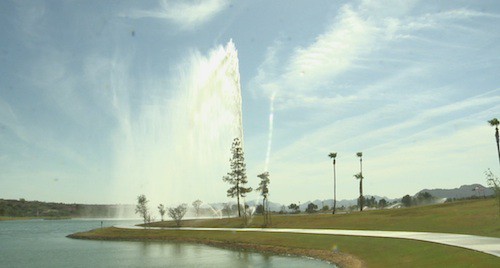Cronkite News has moved to a new home at cronkitenews.azpbs.org. Use this site to search archives from 2011 to May 2015. You can search the new site for current stories.
Fountain Hills weighing options for preventing smells from iconic fountain
FOUNTAIN HILLS – The towering fountain seen from miles around gives this community northeast of the Valley its heartbeat.
Tourists from around the world flock to see what is billed as the world’s largest freshwater, continuously running fountain, which blasts a stream up to 560 feet high for 15 minutes on the hour from 9 a.m. to 9 p.m.
But over the last few years, especially in warmer weather, what’s so pleasing to the eye has sometimes been a bit hard on the nostrils due to algae in the surrounding lake.
“Back in 2010, the lake smelled pretty bad,” said Ron Huber, manager of the Fountain Hills Sanitary District. “Every time the fountain would shoot off, it was sending off some pretty rotten odors.”
It turned out that the algae growth and associated hydrogen sulfide smell had do with the way officials were managing the reclaimed water that fills the lake.
First, a study found the fountain wasn’t running enough to properly circulate the water. At the same time, the sanitary district had stopped using the lake as a reservoir for watering the surrounding golf courses, which led to stagnation.
Now the Town Council, which is responsible for the fountain’s operation, is considering a proposal to transfer control of Fountain Hills’ namesake to the Fountain Hills Sanitary District in the interest of better maintaining the lake.
Council members have reviewed the proposal and given feedback to the sanitary district. No formal action has been scheduled.
While not offering an opinion on the proposal, Mark Meyer, the town’s parks and recreation director, said the sanitary district has experience dealing with reclaimed water and has a water quality expert on staff. At present, the town pays a consultant to deal with water quality in the lake.
“It was their feeling that because they deal with effluent water all the time and because our lake is effluent that they would potentially be in a better position to improve the water quality, more than the town has been able to do,” Meyer said.
The town has tried running the fountain three times overnight to circulate the water, but regular operation already costs around $150,000 in electric bills annually, Meyer said.
While noting that the town’s actions have improved things over the past two summers, Huber said the district might also be in a position to construct a $1 million to $2 million mechanism that would better circulate water.
Businesses in Fountain Hills depend on the fountain’s allure to visitors. Gail Oliphant, owner of Gridley’s, an office and art supply store in business since 1973, said a foul-smelling fountain wouldn’t encourage people to stick around.
“Quite frankly we end up with a lot of tourists that come out because of the fountain,” she said. “So if the tourists weren’t coming out, it would definitely affect our business.”
Over the last few years, Rick Amalfi of Aquatic Consulting has been working with the Town Council to improve water quality in the lake.
“Moving water is very critical to the health of that lake, that’s how the fountain helps, but the fountain isn’t the total answer,” said Amalfi who also oversees water quality for the Tempe Town Lake. “We need more circulation, and we may just be down to who can afford to do more.”
Meyer says Amalfi’s suggestions, such as running the fountain at night and occasional use of chemicals, have improved conditions in the lake.
“We’ve been doing that for the last few years and the incidences of odor has diminished,” Meyer said. “It isn’t, in my opinion, as big an issue as it used to be.”








